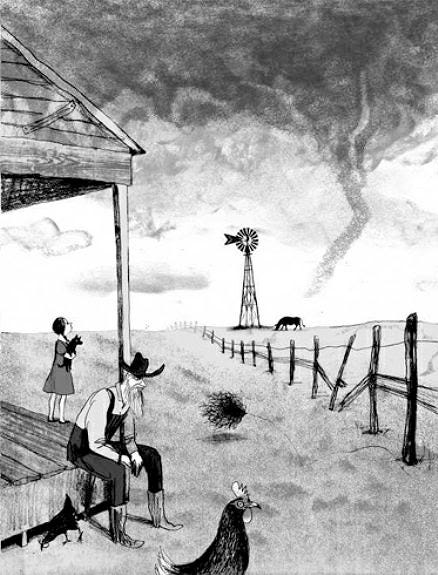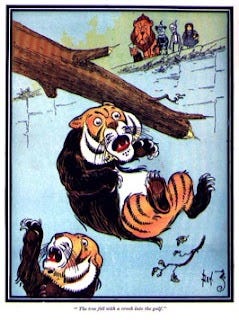Jesus and the Wizard of OZ
Why it's better to have four gospels than one.
"No matter how dreary and gray our homes are, we people of flesh and blood would rather live there than in any other country, be it ever so beautiful. There is no place like home.”1
I answered the phone and heard the familiar but excited voice of one of my parishioners. “Randy,” they said, “did you know that Jesus died four times?” Though I had heard many different religious ideas over the decades as a pastor, this one took me by surprise. All I could say was “What?” Their excitement continued as they said, “Jesus died in the gospel of Matthew, then in the gospel of Mark, a third time in Luke, and a fourth time in John!” Now I understood. She was reading the first four books of the Bible as consecutive chapters of a story. She isn’t the only one who has treated the Bible this way.
Some people feel that to have four accounts of Jesus’ life, death, and resurrection makes the Bible less trustworthy. Specifically, they feel that the differences in the stories undermine truth. Strangely, such an approach assumes that four completely repetitive stories of Jesus would be more trustworthy or that only one gospel would provide more certainty regarding Jesus’ life, death, and resurrection than would four gospels. In truth, having four accounts of Jesus gives us a four-dimensional view of the key person of the faith, something akin to moving from monotone to stereo.
I was reminded of the value of this when I read The Wizard of Oz for the first time. I have seen the movie dozens of times since I was a child, but I had never read the original book. I expected there to be a few differences between the story as told in the book versus the story as revealed in the movie, but was surprised to see so many significant changes both in the characters and even in the story’s theme.
Some minor changes:
Dorothy’s slippers are silver, not ruby.
There is no music or dancing (not even “Lions and Tigers and Bears, O My!”) in the book.
The wicked witch of the West has only one eye.
All the homes in Oz are green.
In Oz, everyone wears green goggles.
In the book, there are two obstacles to overcome on the journey to Oz: a ditch where they encounter creatures known as the Kalidah and a broad river.
Additional characters:
The Munchkins of the East are in the book and the film. The book, however, also includes the Winkies of the West and the Quadlings who live in the south.
There are no angry apple trees in the book.
In the book, the scarecrow is encountered by Dorothy on a Munchkin farm. The Munchkins are much more rural in the book. The first night in Oz, Dorothy is hosted by one of the richest of the Munchkin farmers, named Boq.
The Wicked Witch of the West sends wolves, crows, and bees after Dorothy and her friends before the winged monkeys (which scared me as a small child!) make their appearance.
Later in the story, the same monkeys are called by Dorothy to take the group from the Witches palace to the Emerald City.
Thematic shifts:
Poverty: Dorothy, her Aunt, and her Uncle were much poorer in the book, living in a one-room home and unable to afford any ranch hands. Her Uncle was deeply depressed.
Slavery: There is a much stronger emphasis in the book on the slavery of the Munchkins and their gratitude at being freed by Dorothy.
Character Backstories: We have an entire, rather gory, backstory of how the Tin Man became Tin. It seems that he once had a brain and a heart. Now that he has neither, he has decided that he would choose to have a brain rather than a heart.
Even with all of these differences I found that both watching the Wizard of Oz as a movie and reading it as a book gave me a fuller, richer story than I had by only watching the film. The same holds true with our reading of the four Gospels. Comparing and contrasting all four of them offers us a stereo of sound - a full symphony of understanding. We have the opportunity, for example, to compare the last words of Jesus on the cross in Matthew, Mark, Luke, and John. The goal is not to deepen our trust by aligning them with one another but to deepen our understanding of this event at the heart of Christianity:
"My God, my God, why have you forsaken me?": (Matthew 27:46, Mark 15:34)
both citing Psalm 22, a clue for the reader to refer to the whole Psalm to gain more understanding of Jesus’ experience on the cross.
"Father, into your hands I commend my spirit.": (Luke 23:46)
An invitation to reflect on Psalm 31 in light of Christ on the cross.
"It is finished.": (John 19:30)
signifies the completion of his redemptive work. This includes fulfilling prophecies, atoning for humanity's sins, and offering salvation. The Greek word for this phrase, tetelestai, means "paid in full," suggesting Jesus' sacrifice fully satisfied our debt of sin.
The four gospels are not to be read as consecutive chapters in the story of the Bible, but as four invitations to go ever deeper in our journey with Jesus.
p. 45 early in story (Scruton, chesterton: motives in history)




Very z interesting!